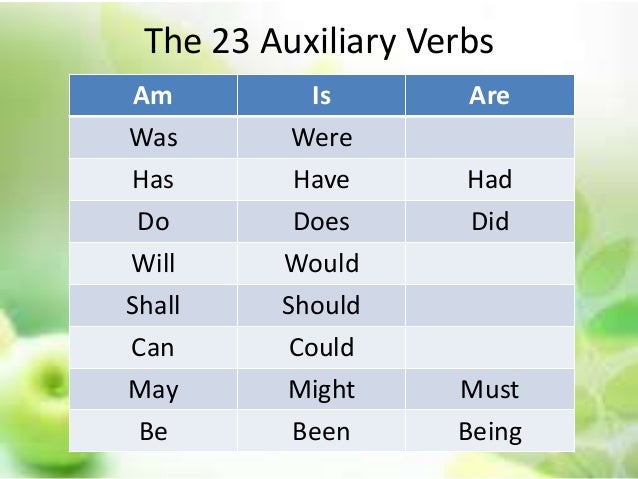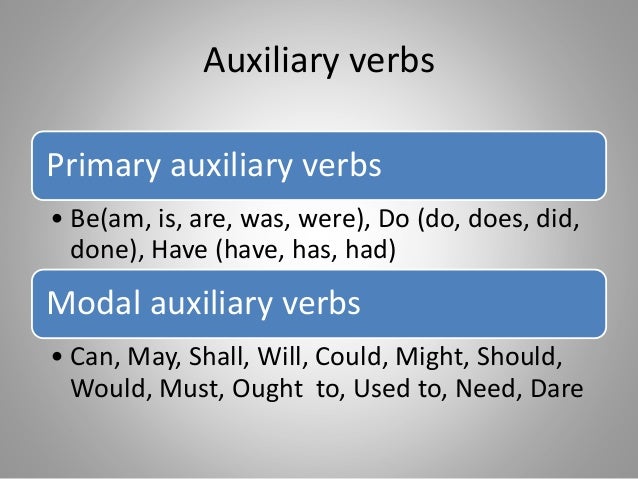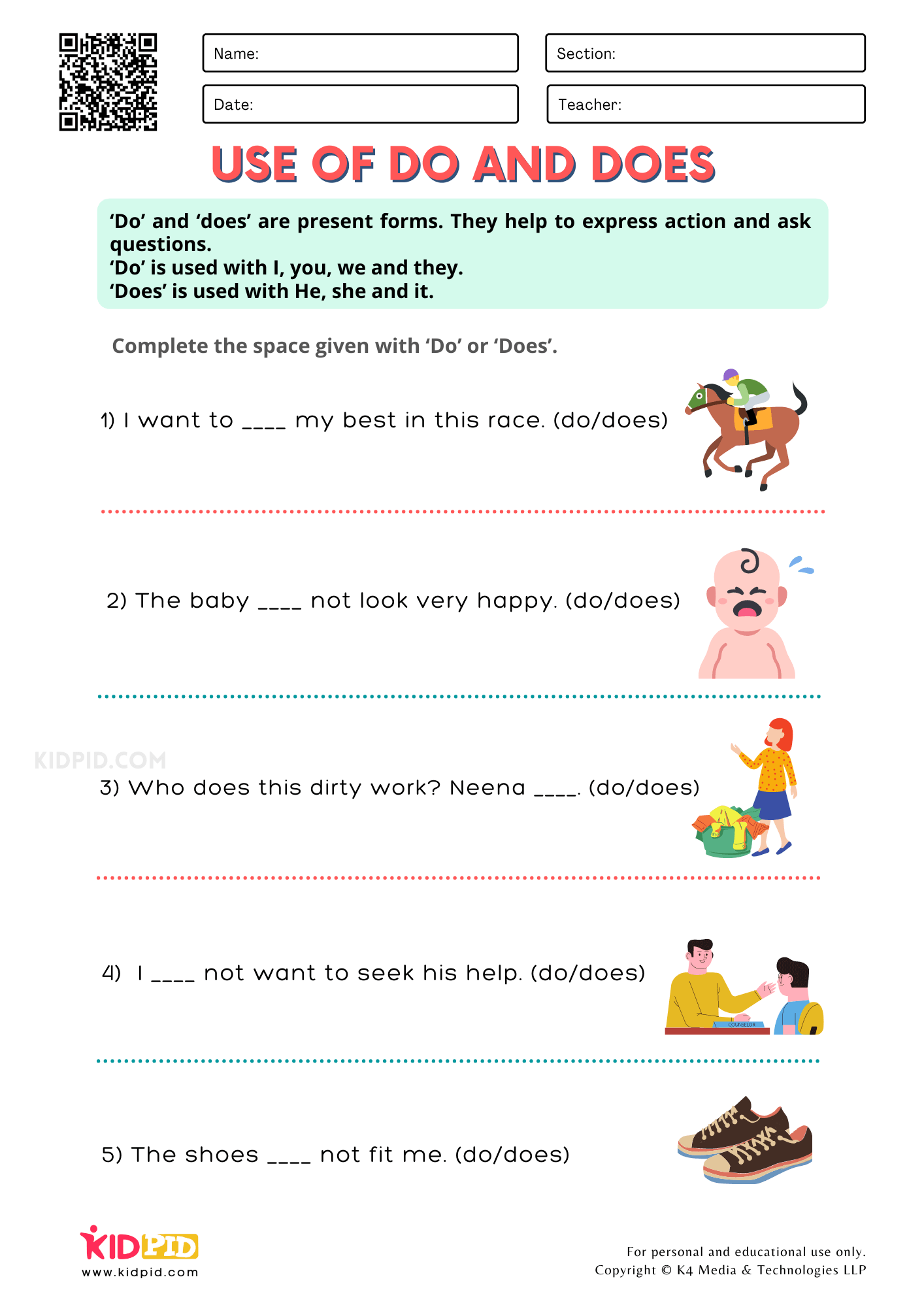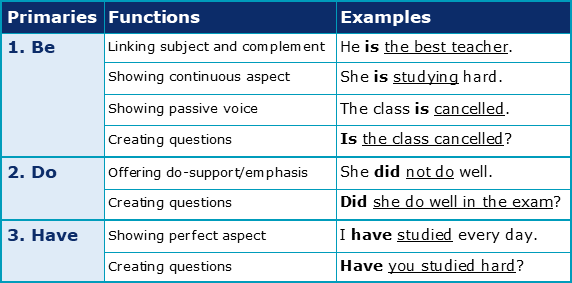In English there are two types of auxiliary verb, primary auxiliaries and modal auxiliaries. The three primary auxiliary verbs are 'be', 'have' and 'do'. There are ten common modal auxiliary verbs and they are 'can', 'could', 'will', 'would', 'shall', 'should', 'may', 'might', 'must' and 'ought'.
Auxiliary verbs are also called helping verbs in English. This is because they are mainly used with the main verbs in structures. Auxiliary verbs are split in two (not, split 'into' two), namely the primary auxiliary verbs and the modal auxiliary verbs. This piece will, in the subsequent paragraphs, discuss the uses and functions of primary auxiliary verbs. Auxiliary verbs usually accompany an infinitive verb or a participle, which respectively provide the main semantic content of the clause.
An example is the verb have in the sentence I have finished my lunch. Here, the auxiliary have helps to express the perfect aspect along with the participle, finished. Some sentences contain a chain of two or more auxiliary verbs.
Auxiliary verbs are also called helping verbs, helper verbs, or auxiliaries. Research has been conducted into split inflection in auxiliary verbs. The three primary auxiliary verbs are 'be', 'have' and 'do'. There are ten common modal auxiliary verbs and they are 'can', 'could', 'will', 'would', 'shall', 'should', 'may', 'might', 'must' and 'ought'. Modal auxiliary verbs often express the ideas of necessity and possibility.
… There are ten common modal auxiliary verbs and they are 'can', 'could', 'will', 'would', 'shall', 'should', 'may', 'might', 'must' and 'ought'. The modal auxiliary verbs are shall, should; will, would; can, could; may, might; and must. The semi-modal verbs need and ] may be used as auxiliaries, although this is not common in contemporary English. Some auxiliaries are usually called modal but often act to give grammatical information by forming a tense with a main verb. For this reason, some people will classifywill and would as Primary Auxiliary verbs.
That is a sensible approach because both verbs can act in both ways. The classification is then split so when they act as primary modal auxiliaries, that is what they should be called and, likewise, when they act as modal auxiliary verbs. The verbs be and have are used as auxiliary verbs to form different tenses of main verbs. Be is used on its own to form the continuous tenses, while have is used to form the perfect tenses. Both have and been are used together to form the perfect continuous tenses. Be and have are used as auxiliaries to conjugate the continuous, perfect, and perfect continuous tenses.
Do is used to make main verbs negative or to form interrogative sentences, and it can also be used to add emphasis to a sentence. Modal auxiliary verbs are can, could, may, might, must, shall, should, will, and would. As you might have already guessed, modal auxiliary verbs are unique in that they cannot stand alone as a main verb and cannot be conjugated into any other forms. They must accompany another verb, and that verb must be in its base form . Modal verbs may also be referred to as mode verbs or modals. An example is the verb have in the sentence I have finished my dinner – here the main verb is finish, and the auxiliary have helps to express the perfect aspect.
The most commonly used primary auxiliary verbs are forms of do, be, and have. In addition, a clause can contain one or more auxiliary verbs. Dare and need are tricky because they function as main verbs or modal auxiliary verbs, although their use as modal auxiliary verbs is becoming increasingly uncommon. When they function as modal auxiliary verbs, they do not conjugate and must be followed by a main verb in its base form. Let's look at some examples of each way dare and need can be used.
The verbs to be, to do, and to have can be used as main verbs, but also as primary auxiliary verbs to build certain tenses or grammatical forms. The verbs to be, to do, and to have can all be used as main verbs, but they are also used as primary auxiliary verbs to build certain tenses or grammatical forms. Yes, again I would like to remind you of the matter that all the three primary auxiliary verbs can function as the main verb to form different tenses. Here is where the English learners sometimes get confused about how it works. In this case, need is functioning as a modal auxiliary verb accompanying the main verb worry.
It is also worth noting that when need is used as a modal auxiliary verb, it will almost exclusively be used in negative sentences. In conclusion, this piece has elucidated the uses and functions of primary auxiliary verbs. A careful perusal would reveal that the knowledge of primary auxiliary verbs is crucial to fluency. The next treatise in this column will focus on modal auxiliary verbs.
We use the primary auxiliary 'have' to form the perfect tenses. We say «I have eaten some chocolate» or «he has been to Sevilla». We could also say «I have been sitting here for ten minutes». We use the perfect continuous tenses to communicate the duration of an action up to a point in time. A verb used in forming the tenses, moods, and voices of other verbs.
The primary auxiliary verbs in English are be, do, and have; the modal auxiliaries are can, could, may, might, must, shall, should, will, and would. The primary auxiliary verbs are the most common of the bunch and are unique in that they can stand alone as main verbs and conjugate accordingly. Go through the sentences given below and say whether the verbs are the main verbs or primary auxiliary verbs.
The "primary" auxiliary verbs—be, have, and do—are some of the most commonly occurring verbs in English. They can be classified into the primary auxiliary verbs and the modal auxiliary verbs. The primary verbs in English grammar are the verbs be, have, and do—all three of which can function as either main verbs or auxiliary verbs.
Primary verbs are sometimes referred to as primary auxiliaries. The primary auxiliary verbs are 'be', 'have' and 'do'. These verbs modify other verbs in a full verb phrase, e.g. 'is going', 'has gone', or 'did go'.
In this example in the past perfect continuous tense, we add the auxiliary verbs had and been, which are forms of have and be. There are two categories of auxiliary verbs, primary auxiliary verbs and modal auxiliary verbs. The "primary" auxiliary verbs are be, have, and do—they occur most commonly in English. Modal auxiliary verbs combine with other verbs to express ideas such as necessity, possibility, intention, and ability. In each example below, the verb phrase is in bold and the modal auxiliary verb is highlighted. The verb that helps the main verb/finite verb to form different tenses, negative sentences, and interrogative sentences is called Primary auxiliary verb.
What Is Primary Auxiliary Verb And Examples Helping verbs are defined as verbs that help the main verb in a sentence by extending its meaning. They add detail to the main verb and are needed to complete the structure of a sentence. They can also clarify how time is conveyed in a sentence. As a result, helping verbs are used to create the complicated progressive and perfect verb tenses.
Learn about the two types of helping verbs and review examples of each. If the negative forms can't, don't, won't, etc. are viewed as separate verbs , then the number of auxiliaries increases. The verbs do and have can also function as full verbs or as light verbs, which can be a source of confusion about their status. The modal verbs form a subclass of auxiliary verbs. Modal verbs are defective insofar as they cannot be inflected, nor do they appear as gerunds, infinitives, or participles.
This example again shows have as the main verb being helped by the auxiliary verb will to form the future tense. When a primary auxiliary verb is not functioning as an auxiliary, it can be accompanied by other auxiliary verbs, just like any other main verb can. In this example, has and been are both auxiliary verbs that form the present perfect continuous tense with the main verb planning. Again, none of the three verbs would be correct or make sense without the others in this context. When it comes to auxiliary verbs, 23 auxiliary verbs stand out.
The "Big Three" auxiliary verbs are "be," "have" and "do" in all their forms. But, there are also a few other auxiliary verbs called modal auxiliary verbs. As auxiliary verbs, we use them before the main verbs to form negation and questions, to create emphatic forms, to form question tags and to form present and progressive tenses. The primary auxiliary verbs in English are to be, to do and to have. They can be used both as main verbs and as auxiliary verbs. Auxiliary verbs, are helping verbs that modify the meaning of the main verbs in a clause.
They are used to make tenses, interrogatives, negatives, passives, and to add emphasis. A word that completes the main verb can be called either the "helping" verb or the "auxiliary" verb. This is a verb used in forming the tenses, moods, and voices of other verbs. Auxiliary verbs used with other verbs form what are called verb phrases or verb strings.
Well, that's true provided we're talking about working in English. If you start learning a foreign language, it won't be too long before you'll be unpicking how they express tense, voice and mood. And, do you know what's a good starting point for that?
Without the help of a 'be' verb, no sentence of passive voice can be formed. As a primary auxiliary verb, it helps form the passive voice of different tenses. The primary auxiliary 'be' is used to form the continuous tenses and the passive voice. For example we say «I am speaking to you now», which is a sentence in the present continuous. In the passive voice the verb 'be' tells us when the action happened. For example if I say, «the window is being opened by him» we know that the action is happening now because the verb 'be' is in the present continuous tense.
In both these cases the verb is followed by the past participle of a lexical or main verb and used to form what is called the passive voice. The passive is often used when the doer of the action is unimportant or unknown and to lay stress on the action itself and the object of the action. In sentence e., the auxiliary be is used alongside the auxiliary have so this sentence shows both perfect aspect and passive voice. This time the main verb is going, and it is accompanied by the auxiliary verb is to form the present continuous tense. Although is is perfectly capable of functioning on its own, in this sentence, like the first example, neither is nor going would be correct or sensible on its own.
Also notice that the auxiliary verb is necessary to make this sentence a question. Without the use of is in its proper place, the sentence would be a declarative statement. The correct intended meaning of the sentence is dependent upon not only the cooperation of the main verb and its auxiliary, but also the proper placement of each.
The complete verb phrase here is ought to eat, the main verb is eat, and the auxiliary verb is ought to. Notice that ought is nearly inseparable from to, and the pair of them function together as one auxiliary verb to mean the same thing as should. Keep the two auxiliary verbs that do this in mind , especially to avoid confusion when dealing with prepositions or infinitives. Also note that ought can be used without to, but such instances are rare and often seen in archaic writing. The complete verb phrase in this sentence is will arrive.
The main verb is arrive, which describes the primary action taking place in the sentence. Adding will puts the action of arriving in future tense, letting us know that Dad will be arriving at some point in the future. Either will or arrive by itself would not be correct or sensible in this case. To properly convey the intended meaning of the sentence, arrive needs the help of will. When this occurs, perfect aspect is superior to progressive aspect, e.g.
The primary auxiliary verb has no meaning of its own. Inversion refers to the reversal of the normal position of the subject and the auxiliary verb of a clause. We cannot use subject-verb inversion with main verbs to create interrogative sentences—we have to either add the auxiliary verb do, or else invert an existing auxiliary verb. Beand haveare used as auxiliaries to conjugate the continuous, perfect, and perfect continuous tenses. Fred may be being judged to have been deceived by the explanation.Viewing this sentence as consisting of a single finite clause, it includes five auxiliary verbs. From the point of view of predicates, judged and scrutinized constitute the core of a predicate, and the auxiliary verbs contribute functional meaning to these predicates.
These verb catenae are periphrastic forms of English, English being a relatively analytic language. Other languages, such as Latin, are synthetic, which means they tend to express functional meaning with affixes, not with auxiliary verbs. Modal verbs may or may not be classified as auxiliaries, depending on the language. In the case of English, verbs are often identified as auxiliaries based on their grammatical behavior, as described below. In some cases, verbs that function similarly to auxiliaries, but are not considered full members of that class , are called semi-auxiliaries.
There has also been a study on auxiliary verb constructions in Dravidian languages. The auxiliary verb helps the main verb in expressing the time the action. In the same sentence, the auxiliary verbs 'is' and 'was' express time of the action in both sentence.
The auxiliary verb 'is' in the first sentence reveal that the action is being done in present. Auxiliary, in grammar, a helping element, typically a verb, that adds meaning to the basic meaning of the main verb in a clause. Auxiliaries can convey information about tense, mood, person, and number. An auxiliary verb occurs with a main verb that is in the form of an infinitive or a participle.





























No comments:
Post a Comment
Note: Only a member of this blog may post a comment.